
Home
Preamble
Index
Areas
Map
References
Me
Drakkar
Saunterings: Walking in North-West England
Saunterings is a set of reflections based upon walks around the counties of Cumbria, Lancashire and
North Yorkshire in North-West England
(as defined in the Preamble).
Here is a list of all Saunterings so far.
If you'd like to give a comment, correction or update (all are very welcome) or to
be notified by email when a new item is posted - please send an email to johnselfdrakkar@gmail.com.
161. Caves, a Waterfall, Windmills and a Crocodile
Two of the joys (for me) of producing these esteemed epistles are that, firstly, they provide some
kind of record of days out which I and, perhaps sometimes, family and friends can look back on,
and that, secondly, since I am the researcher, writer, editor, web-pager and publisher then, however
useless I may be at those tasks, there is nobody to tell me what I cannot do. So last
October I felt free after a visit by our daughter’s family to add an item about a couple of days
touring the Lake District (Sauntering 143),
although it wasn't really about 'walking in north-west England', as the title demands.
Before a visit by our son’s family – Martin and Sarah, plus Evlyn (9), Malachy (7) and
Cormac (3) – I knew that there would be no real walking.
It was much too hot anyway. But then I thought: Why not add an item here? It would amuse me and
possibly us and, who knows, even others. I had given the camera a rest, as I had not anticipated
writing here, so I’m grateful to Martin and Sarah for letting me use some of their photographs.
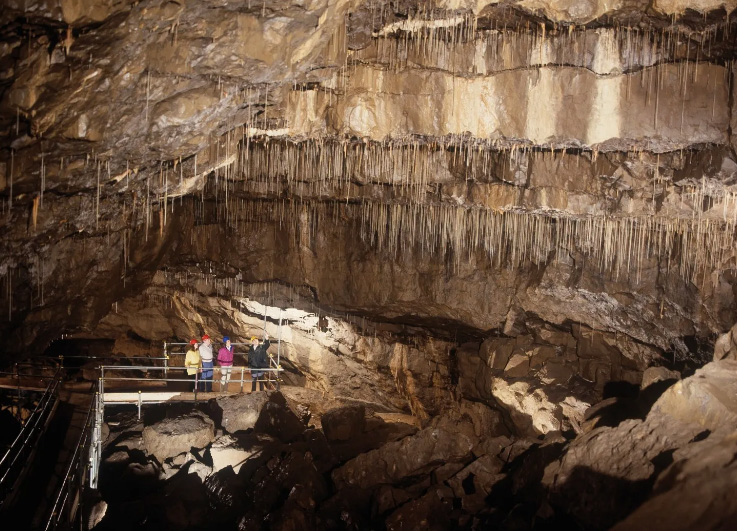 Now, where to take children on a scorching day? Well, the temperature in the White Scar
Caves ranges from a balmy 8°C in a freezing winter to a shiveringly cold 8°C in a heatwave. I
assumed that others would have the same thought but the caves were not over-busy. So, donning
hard hats (to prevent our heads damaging the low rock roofs), we ventured in.
Now, where to take children on a scorching day? Well, the temperature in the White Scar
Caves ranges from a balmy 8°C in a freezing winter to a shiveringly cold 8°C in a heatwave. I
assumed that others would have the same thought but the caves were not over-busy. So, donning
hard hats (to prevent our heads damaging the low rock roofs), we ventured in.
Left: The Battlefield Cavern of White Scar Caves (this photo I pinched from
on-line).
Our guide first
introduced us to an effigy of Christopher Long who had discovered the cave in 1923. He
mentioned that Long had four candles in his hat, which produced giggles among the adults (which
we explained later to the children). He did not, understandably, mention that poor Long, a
manic depressive, died from a drug overdose a year later and gained no benefit from his discovery
except the honour of being mentioned in missives such as this. Others later developed the show
cave, now the longest (about a mile long) in England.
We trekked on into the cave, passing various highlighted features (the Witch’s Fingers, the Sword of
Damacles, the Crown of Thorns, and so on), until reaching the
massive 90-metre long Battlefield Cavern, discovered in 1971. Here
our guide pointed out a second effigy, this one of Hilda Guthrie, who was the first to see the
cavern, or so the guidebooks and
websites say.
Our guide, however, seemed proud of some independent research in which he had tracked down Hilda,
who admitted that it wasn’t actually her who had first seen the cavern but another female caver
of the group, Lesley (I didn’t catch the surname). He then tracked down Lesley, who now lives in New
Zealand, but she didn’t want to discuss the matter. Perhaps there was some group ‘tension’?
Anyway, our guide went on to point out, amongst other things, the straw stalactites. Up to
this point, I hadn’t worn my specs for fear of dropping them in the stream flowing through the
cave but putting them on now the blurry shapes resolved into a wonderful sight of hundreds
of long thin hollow decorations.
Right: Martin and Evlyn at Thornton Force.
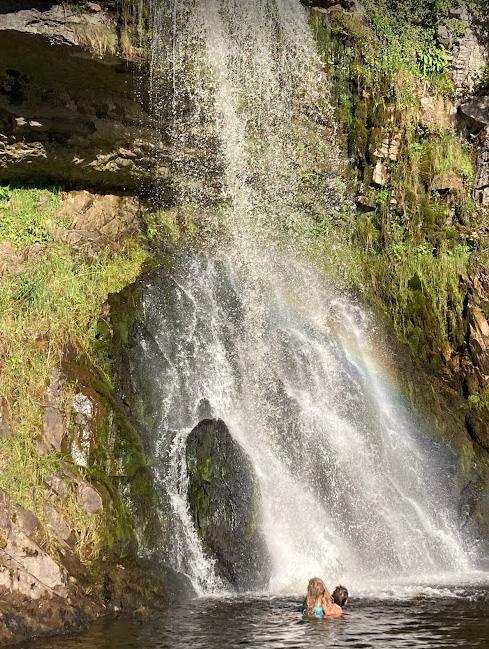
Back outside in the heat and after a shady picnic we headed for Kingsdale to have a
look at Thornton Force [1]. We walked along the track over Kingsdale Beck, lured by the seemingly ever-present
ice-cream van, which was being justly rewarded on such a day for the days it is here in
the wind and rain.
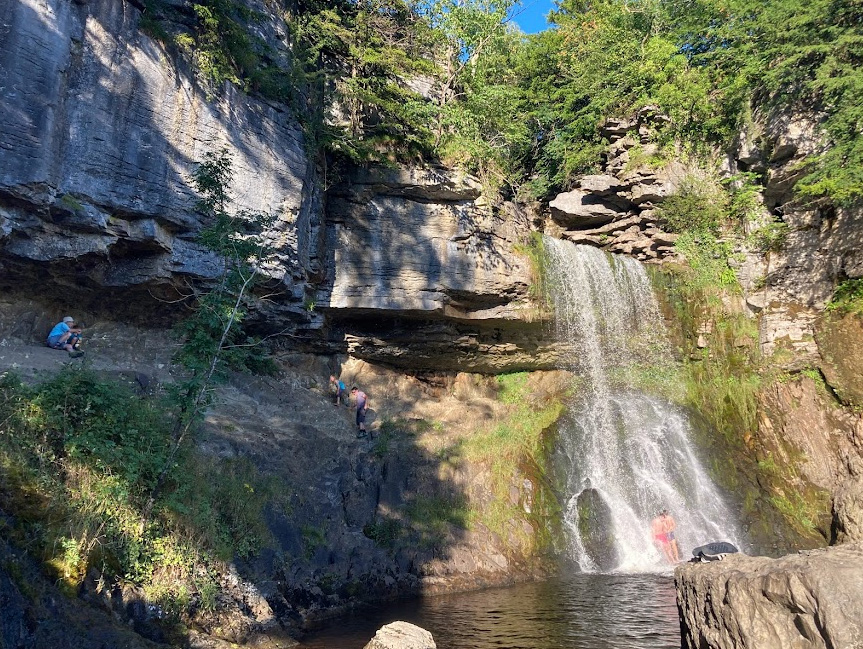 Left: In the overhang of Thornton Force (me with Malachy, Martin with Evlyn - I don't know
who the two standing in the waterfall are).
Left: In the overhang of Thornton Force (me with Malachy, Martin with Evlyn - I don't know
who the two standing in the waterfall are).
We duly reached the waterfall, to see a sight that I had not seen before.
On all previous visits it had been the normal cold, wet and windy weather in which it would
never occur to anyone to enter the deep pool below the waterfall. On this occasion, people
were frolicking in the pool – and we joined them, four in the pool, with the others just paddling.
Most bathers had not, I think, come expecting to swim but had been unable to resist, even
if in their underwear. The children surely won’t forget the day that they swam under a waterfall.
I should warn that it is, I understand, not easy to swim in the pool because of the irregular
heap of large boulders that have been washed over the waterfall and now lurk underwater.
We also took the chance to clamber up behind not quite the waterfall.
As we sat there, I, never one to miss a learning opportunity,
pointed out to the children
the two rocks that our cave guide had mentioned, the white limestone above our heads
and the grey slate below our feet, with us sitting in the 100 million year gap between the two.
On the next, still hot, day we didn’t venture far from home. A morning trip to our local
celebrities, the Caton Moor windmills, always impressive for children – and adults too, found
the windmills rotating vigorously in a breeze too light to sustain a flying kite.
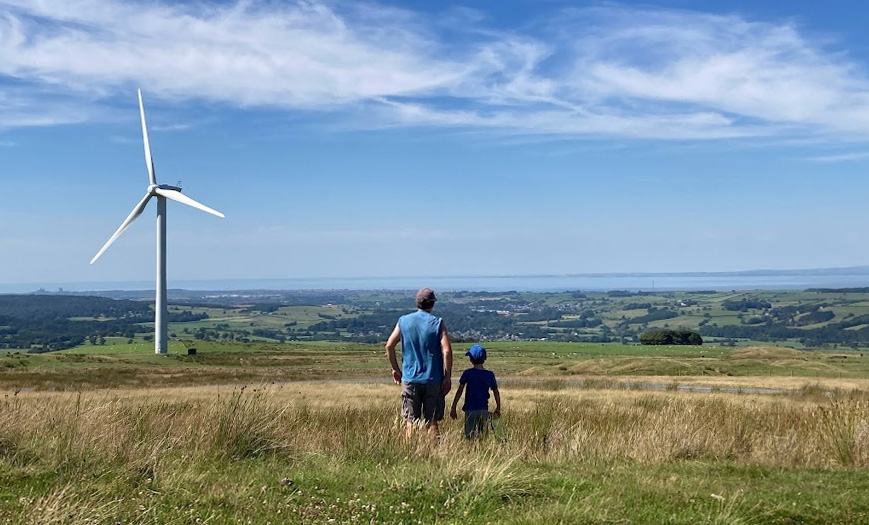
From the Caton Moor windmills looking over Morecambe Bay
The afternoon
was spent at the informal picnic and bathing site where the beck that runs by our garden, Bull
Beck, joins the River Lune. Here Martin rescued a crocodile.
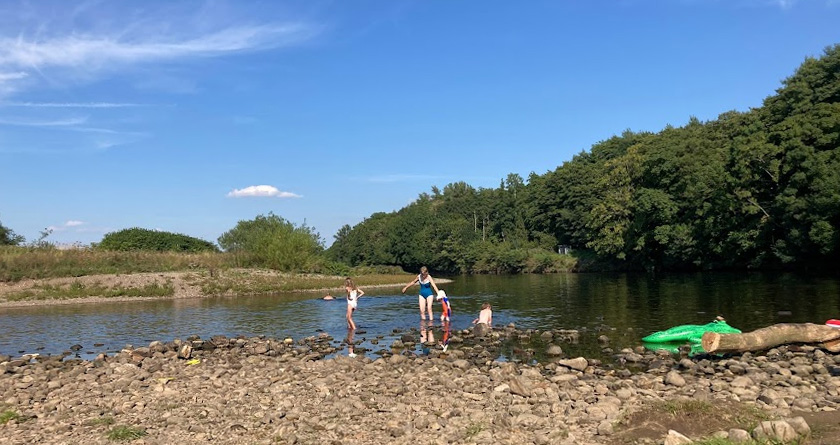 Left: At the River Lune (this photo somehow managed to exclude everyone else).
Left: At the River Lune (this photo somehow managed to exclude everyone else).
We are frequently warned of the dangers of wild swimming. However, we will never stop – and
nor should we – people migrating to such spots on hot days. Perhaps it would be better to explain
clearly what the dangers are. It is hard to see any here, when the river is so low. Even a
feeble swimmer such as myself can cross the river, although the mild current made my path more
diagonal than direct. Actually, I could have walked across.
The majority of the bathers were, as you’d expect, boisterous youths,
ducking and diving, with the boldest of them climbing a tree to plunge into the deep pool of
the Dub, as generations have done before them.
Near us was a group with a minuscule dog that some might consider cute. At one point,
the group all went into the river, abandoning the dog, which after a while began to wonder where
they were and set off looking for them. The dog was adopted by a barely-dressed young woman,
who paraded about, hugging the tiny dog, ostensibly looking for the owners but in
reality hoping to establish an unbreakable bond with the dog.
Sadly for the dog, its owners returned, loudly blaming each other for letting
their inflatable crocodile drift away in the current. Martin retrieved
the crocodile from downriver, thereby preventing mass panic
among bathers at the Crook o'Lune.
 Right: I have no idea what these two are up to.
Right: I have no idea what these two are up to.
In all seriousness, though, after joining with others finding opportunistic fun in the
heatwave I fear that it is not the climate change sceptics and deniers that we need to worry about
but the climate change welcomers.
[1]. In case you should think me a miser (which I might be) and an encourager of trespass
(which I might be) I should explain. It costs about as much to see the White Scar Caves as to
walk the Ingleton Waterfalls Trail. It is obvious that it has taken considerable
work and expertise to open up the caves and make them safe for the public, whereas
the waterfalls are already 'opened up' and the construction of three footbridges does
not compare to the work necessary for the caves. There are no guides showing us the waterfalls.
It is unreasonable to require everyone to walk the five-mile trail,
especially on such a hot day and especially young children. Why should they, with their lively
interest in nature, be denied
access to one waterfall just because a way cannot be devised to enable us to pay for what we
want to see? I would happily pay a proportionate amount to see Thornton Force – but the waterfall
is on open access land and therefore free to all, accessible
from the lane in Kingsdale. However, I haven’t noticed a gate in the stone wall by the lane
and it is unwise to climb it. It is better to walk down the track, on open access land, over
Kingsdale Beck and then boldly cross a field labelled ‘private’ to regain open access land.
The path could easily have been kept on open access land. They can’t expect us to pay £44 by
making us walk 100 metres across a field!
Date: August 12th/13th 2022
Home
Preamble
Index
Areas
Map
References
Me
Drakkar
© John Self, Drakkar Press, 2018-

Top photo: The western Howgills from Dillicar;
Bottom photo: Blencathra from Great Mell Fell


 Now, where to take children on a scorching day? Well, the temperature in the White Scar
Caves ranges from a balmy 8°C in a freezing winter to a shiveringly cold 8°C in a heatwave. I
assumed that others would have the same thought but the caves were not over-busy. So, donning
hard hats (to prevent our heads damaging the low rock roofs), we ventured in.
Now, where to take children on a scorching day? Well, the temperature in the White Scar
Caves ranges from a balmy 8°C in a freezing winter to a shiveringly cold 8°C in a heatwave. I
assumed that others would have the same thought but the caves were not over-busy. So, donning
hard hats (to prevent our heads damaging the low rock roofs), we ventured in.

 Left: In the overhang of Thornton Force (me with Malachy, Martin with Evlyn - I don't know
who the two standing in the waterfall are).
Left: In the overhang of Thornton Force (me with Malachy, Martin with Evlyn - I don't know
who the two standing in the waterfall are).

 Left: At the River Lune (this photo somehow managed to exclude everyone else).
Left: At the River Lune (this photo somehow managed to exclude everyone else).
 Right: I have no idea what these two are up to.
Right: I have no idea what these two are up to.
